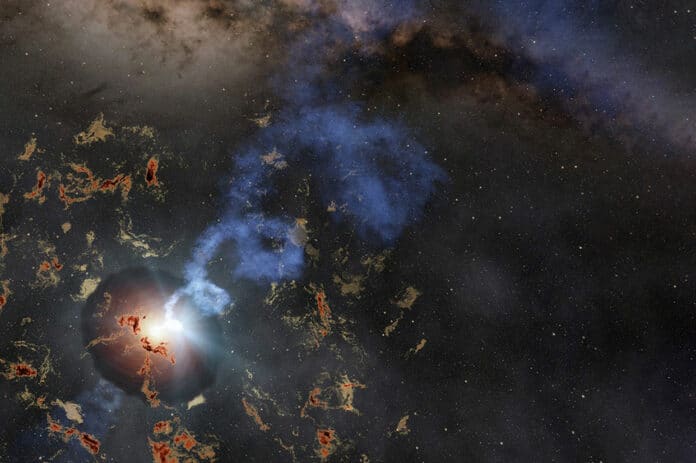A Cornell-led team reveals that following the cataclysmic death of a distant star, an active stellar corpse was most likely the cause of many intense flares recorded over several months. This was a scenario that had never been witnessed by astronomers before.
The scientists were searching for a unique kind of stellar cataclysm known as a luminous fast blue optical transient, or LFBOT- officially labeled AT2022tsd and nicknamed ‘the Tasmanian devil’ when they noticed the brilliant, fleeting flashes that lasted as little as a few minutes and were just as violent as the original explosion 100 days later.
In recent years, certain luminous extragalactic optical transients have been observed to last only a few days. Their short observed duration implies a different powering mechanism from the most common luminous extragalactic transients (supernovae), whose timescale is weeks. Some short-duration transients, most notably AT2018cow, show blue optical colors and bright radio and X-ray emissions.
Several AT2018cow-like transients have shown hints of a long-lived embedded energy source, such as X-ray variability, prolonged ultraviolet emission, a tentative X-ray quasiperiodic oscillation, and large energies coupled to fast (but subrelativistic) radio-emitting ejecta.
AT2022tsd is an AT2018cow-like transient. Scientists characterized AT2022tsd and ensured pulses of light seen roughly a billion light-years from Earth.
Anna Y. Q. Ho, assistant professor of astronomy in the College of Arts and Sciences, said, “We don’t think anything else can make these kinds of flares. This settles years of debate about what powers this type of explosion and reveals a straightforward method of studying the activity of stellar corpses.”
While sorting through the half-million changes, or transients, seen every day in an all-sky scan carried out by the California-based Zwicky Transient Facility, Ho built the software that spotted the event in September 2022.
Then, in December 2022, as Ho and collaborators Daniel Perley of Liverpool John Moores University in England and Ping Chen of the Weizmann Institute of Science in Israel continued to monitor the fading explosion regularly, they got together to discuss fresh observations and examined by Ping. These observations consisted of five images, each lasting several minutes. As anticipated, the first revealed nothing, but the second told light, then an extremely bright spike in the middle frame that rapidly disappeared.
The scientists partnered with colleagues who provided views from over a dozen telescopes, including one outfitted with a high-speed camera, to delve deeper into the sudden rebrightening. The group went through previous data and attempted to rule out other potential light sources. In the end, their investigation verified that throughout 120 days, at least 14 irregular light pulses occurred; this is a small portion of the total.
Ho said, “Amazingly, instead of fading steadily as one would expect, the source briefly brightened again – and again, and again. LFBOTs are already a kind of weird, exotic event, so this was even weirder.”
“In the case of LFBOTs, rapid rotation or a strong magnetic field likely are key components of their launching mechanisms. It’s also possible they aren’t conventional supernovas, instead triggered by a star’s merger with a black hole.”
“We might be seeing a completely different channel for cosmic cataclysms.”
“The unusual explosions promise to provide new insight into stellar lifecycles typically only seen in snapshots of different stages – star, explosion, remnants – and not as part of a single system. LFBOTs may present an opportunity to observe a star in the act of transitioning to its afterlife.”
“Because the corpse is not just sitting there; it’s active and doing things that we can detect. We think these flares could be coming from one of these newly formed corpses, which allows us to study their properties when they’ve just been formed.”
Journal Reference:
- Ho, A.Y.Q., Perley, D.A., Chen, P. et al. Minutes-duration optical flares with supernova luminosities. Nature (2023). DOI: 10.1038/s41586-023-06673-6
